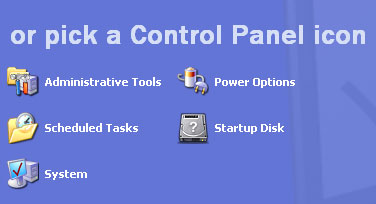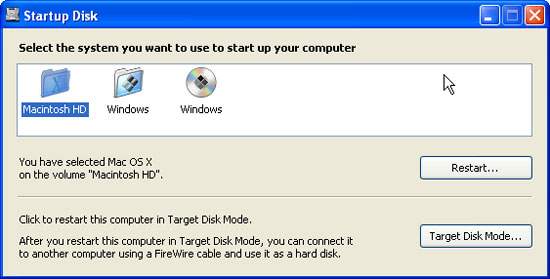Apple's MacBook Pro: Using it as a Mac and a PC
by Anand Lal Shimpi on April 13, 2006 12:00 AM EST- Posted in
- Mac
I had to enter my CD key and deal with activation just like you would on a PC, and then I was placed at the Windows desktop. The next step was to toss in the driver CD created earlier, and Windows' autorun feature will start a driver installation wizard for the MacBook Pro.
While there's an occasional Continue or Next button to click, the process is mostly automated as it installs the MacBook Pro's chipset, video, audio, network and input drivers. Thanks to having complete control over the hardware configuration Apple has made the process of installing Windows on your Mac easier than it is installing it on your PC. With all of the drivers installed, there's one last reboot and the process is complete. I'd just installed Windows XP on my MacBook Pro and now it's time to use it.
![]()
After installing Windows XP, by default the MacBook Pro boots to the Windows partition . This behavior can be changed in the Startup Disk utility: Control Panel > Performance > Startup Disk and select the default boot partition. If you happen to have a bootable CD/DVD in the drive you can even choose to boot from that.


While the control panel option will permanently change the system's default behavior, if you want to temporarily boot to a different partition simply hold down the option key while the MacBook Pro starts up to access the boot menu.

It takes no more than a few minutes using Windows XP on the MacBook Pro before you realize that a number of things feel out of place. The biggest problem is that there's no right mouse button, which in OS X you get around by holding down the ctrl key and clicking, but in Windows XP ctrl + click does nothing. There is a utility out there that will make holding the ctrl key down swap your left and right mouse buttons temporarily, effectively making ctrl + click function as a right click under Windows. The utility works as advertised; you just need to make sure it loads at startup to always have support for a right mouse button. The other option to right click is to hit Shift + F10, but obviously it's not the most natural feeling.
Apple's driver CD installs a driver to enable support for the eject key on the MacBook Pro keyboard, which is very helpful because without it or any support for a right click, getting a CD/DVD to eject is far more trouble than it should be. The fn key is also not supported under Windows XP, which means that not only do you lose support support for the function hotkeys but you also lose any support for page up, page down, home and end keys.
Although Apple clearly states that the integrated iSight camera is not supported under Windows XP, a camera icon does show up in My Computer. However, I made the mistake of doubling clicking it which gave me my first blue screen on a Mac. Needless to say, I didn't make that mistake again.
My only other complaint about using Windows XP under Boot Camp on the MacBook Pro is that I could never get the mouse sensitivity to be at a level I was perfectly comfortable with. The default setting was far too slow (just like under OS X), but cranking it up to where I would like it made the pointer behave a little too erratically when trying to perform more minute movements. The trackpad was obviously fine under OS X, so it sounds like it's just a driver thing under Windows XP.
In terms of usability, Windows XP under Boot Camp is pretty much like Windows XP on any other notebook other than the aforementioned keyboard/trackpad limitations; I've got no complaints there. And yes, you can even run games on your notebook, but keep in mind that the MacBook Pro's Mobility Radeon X1600 isn't going to be able to run the latest games at their highest detail settings.
Honestly, it would seem that fixing the issues I had with Boot Camp would be fairly simple for Apple to do with a more extensive keyboard driver. Much like Apple did with their eject button driver, doing the same for the other keys that currently don't work would fix a lot of the problems. It could be that Apple either released the Boot Camp beta earlier than it expected to, or that Apple wants to make the Windows XP experience as poor as possible on the MacBook Pro.










52 Comments
View All Comments
Calin - Thursday, April 13, 2006 - link
This could be thanks to slower drivers in BootCamp Windows XP, or slower hard drive access/speed. Everything else is a disadvantage for VM: one more level of indirection in disk access, less memory, running the OS X behind the VM.Could you do some disk speed comparation between VM and native XP?
BigLan - Thursday, April 13, 2006 - link
I think it's going to be hard drive speed throwing off the benchmarks. The BootCamp partition is going to be at the outer edge of the disk, with much slower speeds than the VM client virtual drive which is on the faster Apple partition.I'm not sure if it's possible to assign the entire HD to a windows partition using Bootcamp, but that's about the only way i can think of to level the playing field.
Calin - Friday, April 14, 2006 - link
To nitpick, it would be at the center of the hard drive, not at the outer edge :) (ok, based on sector numbers, which starts at the edge).Near the "end" of the hard drive, the transfer speed is reduced (there are fewer bytes on a full circle).
jimmy43 - Thursday, April 13, 2006 - link
Excellent Review. This may be my first laptop purchase, seems to have everything I could possibly want.monsoon - Thursday, April 13, 2006 - link
Hello Anand,...i'm waiting for Parallels to finalize their VT release and maybe Merom Macs too...
I was wondering if the ONE CORE only VT tech is to be the final result of their virtualization software or just a middle-step.
Seems to me it's rather poor a solution ( ok, it's the best out there for now ) to use a dual-core computer to run both OS on a single core
=/
Better would be smart distribution of tasks to the CPU depending on which OS is actually under load...
...any thoughts / info on that ?
Thanks for your nice review !=)
plinden - Thursday, April 13, 2006 - link
Looking at CPU load while running Parallels VM, I see the load spread evenly over both processors (usually < 10% total CPU except at boot, when it reaches 150% CPU). It's just that the VM itself sees itself as running on a single processor.
shuttleboi - Thursday, April 13, 2006 - link
I've read that the ATI X1600 in the Mac can run games well, but only IF you overclock the GPU. I can't imagine the Mac getting any hotter than it already supposedly is, and the idea of overclocking an already hot laptop is not appealing.JoKeRr - Thursday, April 13, 2006 - link
Overall I enjoyed it.Would have been nice to see a comparison of screen brightness, as apple claimed 67% brighter!
And also, the slowness in windows, could it be related to chipset driver stuff?? And what's the gaming experience so far like?? Would it be similar to a desktop 6600 or 6600gt??
Thank you.
rolls - Friday, April 14, 2006 - link
Very interesting numbers all round.35% improvement in iTunes when comparing a single core 1.5GHz 7447 with the old slow bus etc, and a new 33% faster dual core intel CPU. 50% improvement in H.264 encoding etc. These numbers suggest that had Apple stuck with Freescale and moved to e600 core based systems, performance figures could have been off the scale. If only...
JarredWalton - Thursday, April 13, 2006 - link
On paper the X1600 Pro desktop cards actually look pretty decent. 12 pipelines at 500 MHz, with 800 MHz RAM. I would have thought they would at least give the 6600GT a run for the money, given how X1800 compares to 7800. Amazingly (to me), the X1600 gets completely stomped by the 6600GT. What's worse, the cards I have can't even overclock worth a darn on the memory side - 800 is stock, and they get unstable at even minor changes. (Could be an issue with the overclocking tool, though?)Anyway, for now I would say X1600 Mobility is going to be somewhere in the realm of 6600 (non-GT) performance, maybe slightly faster. That means gaming is definitely possible, but you will want low-to-medium detail levels for any recent titles. Just a guess, of course, and Anand will have to run benches to get any final confirmation. Really, though, this laptop isn't intended as anything more than a light gaming solution.